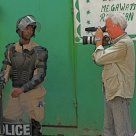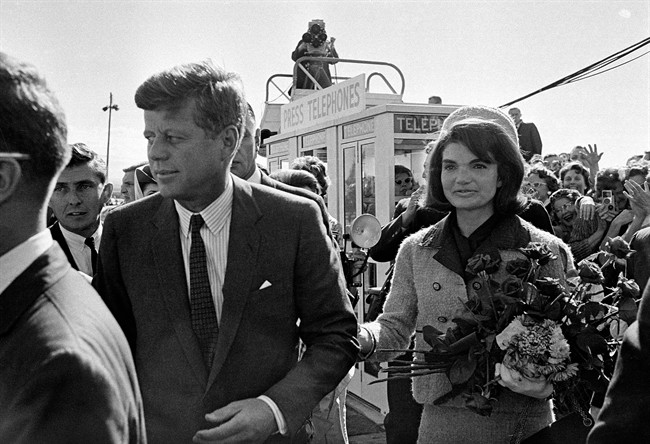In the course of producing a TV piece marking the 50th anniversary of JFK’s assassination, I had the occasion to watch the 26-second Zapruder film over and over again. It’s probably the most famous 8-mm film in history: recording the last moments of Kennedy’s life, including Frame #313, as his head explodes with the impact of a bullet, and Jackie Kennedy reflexively scrambles over the rear of the presidential limousine to gather his brain matter.

Read more: JFK 50 years later
A Dallas citizen, Abraham Zapruder, took the footage and later sold it to Life Magazine for $150,000. It was the prime piece of evidence for the Warren Commission which concluded, controversially, that Lee Harvey Oswald was the lone assassin. (A majority of Americans disagreed then, and still do.)
Only one other image from that time even comes close to the shock effect of the Zapruder film—the shooting of Oswald two days after the Kennedy assassination. It was carried on live TV as Oswald was being escorted by plainclothes police.The shooter, in this case, was a shady nightclub owner, Jack Ruby, who himself later died in prison. I was 15 when I saw the Oswald shooting on television with my father after Sunday Mass, and it left us both speechless and gasping. Could this really be happening?
It was my first experience with reality television in its rawest form, and it had one curious effect. It stretched my credulity to the breaking point. It was as much horror as a 15-year-old mind could assimilate—a president killed, his killer killed, his killer’s killer dead. When the various conspiracy theorists began to spin out their fantastic scenarios, there was no more room in my imagination.
The theories were mind-boggling in their reach. Vice-president Lyndon Johnson was behind it. No, it was the CIA. No, it was the Mafia, maybe in league with Kennedy-hating Cuban Americans. How about Castro? Or J. Edgar Hoover, afraid that Kennedy was about to force him into retirement? How to account for the “three tramps” seen on the Grassy Knoll with guns? And what about Oswald’s dark connection with the Soviet Union? Or the right-wing extremists in Texas who hated Kennedy’s stand on civil rights?
Over the years, the list of plots grew longer, the skepticism ran deeper. The most intriguing theory has been labeled the “oops, I shot the president” story, proposed by Australian detective Colin McLaren. McLaren asks us to believe that after Oswald fired the shot that struck Kennedy in the neck, Secret Service agent George Hickey—in a car right behind the presidential limo– accidentally discharged his rifle when his car lurched forward, and it was his bullet that killed Kennedy.
Inevitably, someone would come forward and insist that “No, I shot Kennedy,” and the first one past the gate was convicted felon James Files who said, from prison, that he killed Kennedy at the behest of a group of organized crime figures. Files is not to be confused with the Mossad hit man hiding in the trunk of the presidential limousine, or the chauffeur who deftly shot Kennedy while driving that same limousine.
Hundreds of books have been written about the assassination, many of them based on the premise that the leader of the Free World could not possibly have been erased by a nonentity like Oswald. Many of the theorists come from the extreme edge of paranoid America: If they can fake the moon landing, the thinking goes, they can cover up the killing of a President.
Then along came Oliver Stone’s political thriller JFK — nominated for eight Oscars. With Kevin Costner in the lead role, that 1991 movie brought conspiracy thinking into the mainstream. It was now cool to be aggressively skeptical.
But whenever anybody approaches me with a new conspiracy theory, I reach for The Umbrella Man. He’s my all-purpose antidote.
If you look at the photographs and the film of the Kennedy motorcade, you will see that it is a bright sunny day in Dallas. Yet at one spot along the route stands a figure under a black open umbrella. And he happens to be standing near the limousine when the fatal shots are fired. Inevitably, The Umbrella Man was dragged into the conspiracy circle, possibly as a sinister hit man with a gun hidden under the umbrella. Or else, he was the spotter who opened the umbrella as a signal for an assassin to shoot. The Umbrella Man was eventually identified. His name was Louie Steven Witt, and in 1978, he went to Washington with his umbrella to talk about his purported role in the Kennedy assassination.
Witt told the House Select Commission on Assassinations exactly what the umbrella was all about. He was at the Dallas motorcade, he said, to protest the appeasement policies of JFK’s father Joe Kennedy, who was the US ambassador to England in the 1930s and sympathized with Prime Minister Neville Chamberlain. The umbrella was a reference to Chamberlain, best known for allowing Adolf Hitler to invade neighbouring countries in an effort to avoid war. Chamberlain went everywhere with his umbrella. Witt said he was sorry that he caused such a fuss.
Reality spiked a great story.
I like what documentary film-maker Errol Morris says about conspiracy theories.
“Conspiracy theories often provide solace,” he says. “They provide a level of comfort that makes sense of a world that seems otherwise beyond our ken, our control.”
“It gives us a picture of evil that is manageable. . . . While the lone assassin suggests that almost anyone you pass by on the sidewalk could be a ticking time bomb.”
And who wants to live in a world where evil is so commonplace, so bland?
Don’t miss “JFK: 50 years later” this Saturday at 7pm on 16X9.


Comments